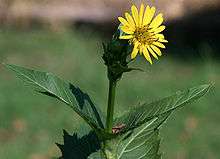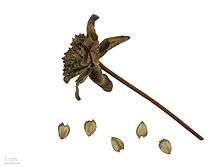Silphium perfoliatum
| Cup Plant | |
|---|---|
 | |
| Scientific classification | |
| Kingdom: | Plantae |
| (unranked): | Angiosperms |
| (unranked): | Eudicots |
| (unranked): | Asterids |
| Order: | Asterales |
| Family: | Asteraceae |
| Tribe: | Heliantheae |
| Genus: | Silphium |
| Species: | S. perfoliatum |
| Binomial name | |
| Silphium perfoliatum L. | |
Silphium perfoliatum, the cup plant[1] or cup-plant, is a species of flowering plant in the family Asteraceae, native to eastern and central North America. It is an erect herbaceous perennial with triangular toothed leaves, and daisy-like yellow composite flower heads in summer.[2]
The specific epithet perfoliatum means "through the leaf."[3]
There are two varieties:-
- S. perfoliatum var. connatum
- S. perfoliatum var. perfoliatum.[4]
Common names
|
Description


The typical height of this plant ranges from 1–2.5 m (3–8 ft). The stem is stout, smooth, slightly hairy (glabrous) strongly 4-angled (square), like mint plants.[7] The leaves are opposite, toothed and ovate.[8] The petioles are widely winged and fused around the stem, forming a cup. The first flower develops on the tip of the main stem, then more flowers develop on side branches.[6]
No other species of Silphium in Michigan have fused leaf bases.[7]
Flowers
The flowers, which appear from midsummer to autumn (fall),[7] look very similar to sunflowers, measuring about 2.5 cm in diameter, with golden yellow ray florets. In the middle of the flower there are small, sterile, tubular disk florets,[5] which are structurally bisexual, but the stamens are the only fertile part, and they do not produce fruit. The corollas are tubular, 5-toothed, and the style is undivided.[9]
Seed production

The ray florets have female characteristics,[6] and eventually develop to become thin brown achenes with a marginal wing utilized for wind dispersal.
Insect pollinators including bees, butterflies, and skippers help to cross-fertilize flowers to produce seeds. 20 to 30 seeds are created in each flower head. Each seed is about 9 to 15 mm long, 6–9 mm wide, flattened in shape, with a thickness of 1 mm.[6]
[10] Silphium perfoliatum is able to establish colonies due to its central taproot system and shallow rhizomes. A multi-rhizomed clone originating from a single seed is believed to be 15 years old. The roots found in botanical gardens have been estimated to be more than 50 years old. The plant has an extensive root system and does not transplant well except when very young.[6]
The plant metabolises by the Type C3 Pathway. This plant is highly adapted to endure extreme weather and inhospitable conditions. For example, during the winter, the roots remain dormant and can survive down to −30 °C (−22 °F). Its optimal growing temperature is 20 °C (68 °F)20 degree Celsius.[6] When flooded it can stay alive for 10 to 15 days.
Habitat and distribution

S. perfoliatum grows in sandy moist bottom lands, floodplains, near stream beds, in or adjacent to open woodland.[6] Currently, it can be found in the following states: USA (AL, AR, CT, GA, IA, IL, IN, KS, KY, LA, MA, MD, ME, MI, MN, MO, MS, NC, ND, NE, NJ, NY, OH, OK, PA, SD, TN, VA, VT, WI, WV), CAN (ON, QC) [11]
The plant is listed as a threatened species in Michigan.[12] It is listed as a prohibited, highly invasive plant species in New York State.[13]
Cultivation
This species is sold by a good number of native plant nurseries and some specialty nurseries in the US and Canada; rare in conventional nurseries. It is often used in prairie and native meadow restorations and in native, naturalistic landscapes and gardens; only infrequently in conventional landscapes and gardens by landscape designers and architects that know of it as a unique looking perennial. A large patch was planted at Millennium Park in Chicago, Illinois, near the Lurie Garden, doing well circa 2010. In gardening and landscaping it is best used in groups and not individually, as it is so vertical and the flower stalks are more likely to fall over some when by itself. Its flowers make it a useful plant for many pollinators, and the seed as food and the "cups" along the stems for drinks of water make it useful for birds. It does best in full sun and moist to draining wet soils that are slightly acidic to slightly alkaline. During the 1750s, the species was introduced to the United Kingdom and the Soviet Union, and has been prized as an ornamental plant since. It was named in 1759 by Carl Linnaeus.[6] It has gained the Royal Horticultural Society's Award of Garden Merit.[14]
Other uses
S. perfoliatum is considered to have a high feed value for meat and milk producing farm animals because of its longevity and high protein levels.[6]
The plant produces a resin that has an odor similar to turpentine.[15] The plant contains a gum and resin; the root has been used medicinally.[3] The resin has been made into chewing gum to prevent nausea and vomiting.[5] Native Americans would cut off the top of the plant stalk and collect the resinous sap that was emitted from the plant. The resin was used for a chewing gum to freshen breath. The Winnebagos Tribe believed that a potion made from the rhizome would provide supernatural powers. The people belonging to the tribe would drink this potion before hunting.[5] The people of the Chippewas tribe used the root extract for back and chest pains, to prevent excessive menstruation, and to treat lung hemorrhage.[16] During the spring, the tender young leaves were cultivated as an acceptable food source by cooking or a salad.[5]
The powdered form of Silphium perfoliatum L. has diaphoretic and tonic properties. It can help alleviate the symptoms of fevers, dry cough, asthma, spleen illness, heart and liver disease. The extract from the leaves of the plant has shown to lower cholesterol and triglycerides levels in blood. Studies show that the presence of phenolic acids is responsible for the species’ antiseptic activity to stimulate generation of IgG and IgM antibodies. In addition, it stimulates bile production of the gall bladder.[17]
Silphium perfoliatum contains amino acids, carbohydrates (inulinin rhizomes), L-ascorbic acid, terpenes with essential oils, triterpene saponins, carotenoids, phenolic acid, tannins, and flavonoids.[15]
The long blossoming season and abundance of flowers provides a rich source for bees and the cultivation of honey.[6]
Disease and herbivory
This species can be targeted by a fungus called Sclerotinia during the summer. During cool temperatures in autumn, the fungus Botrytis will cause the flower buds to wilt and turn black before blooming.[6] Eggs of the gall wasp are deposited within the stems of this plant. Consequently, the developing larvae feed within the stems. Goldfinches feed on the seeds of Silphium perfoliatum and drink the water collected by the “cups” on the stems. The fact that this species is able to form dense colonies, it provides a good shelter for birds. Herbivores such as cattle and sheep will eat the leaves of the plant especially those of young plants.[18]
References
- ↑ "Silphium perfoliatum". Natural Resources Conservation Service PLANTS Database. USDA. Retrieved 15 November 2015.
- ↑ RHS A-Z encyclopedia of garden plants. United Kingdom: Dorling Kindersley. 2008. p. 1136. ISBN 1-4053-3296-4.
- 1 2 "Plants of the Eloise Butler Wildflower Garden". Friends of the Wild Flowers. 2008. Retrieved 15 May 2011.
- ↑ "ITIS Standard Report Page: Silphium perfoliatum var. connatum". Itis.gov. 2010-05-13. Retrieved 2012-09-06.
- 1 2 3 4 5 Favorite, Jamie (2002). "Plant Guide: Cup Plant Silphium perfoliatum L." (PDF). USDA NRCS National Plant Data Center. Plants.usda.gov. Retrieved 15 May 2010.
- 1 2 3 4 5 6 7 8 9 10 11 Stanford, Geoffrey (1990). "Silphium perfoliatum (Cup-Plant) as a New Forage.". Proceedings of the Twelfth North American Prairie Conference. Vol. 12, x. 218, pp. 33-38. Retrieved 15 May 2011.
- 1 2 3 4 Penskar, M.R.; Crispin, S.R. (2010). "Silphium perfoliatum L. (cup plant)" (PDF). Special Plant Abstract for Silphium perfoliatum. Lansing, MI: Michigan Natural Features Inventory. pp. 1–3. Retrieved 15 May 2011.
- ↑ "Silphium perfoliatum". Invasive Plant Atlas of New England. 2009. Archived from the original on 24 March 2012.
- ↑ Britton & Brown, Illustrated flora of the northern states and Canada. III. New York: C. Scribner's sons. 1913. ISBN 0-486-22644-1.
- ↑ Hilty, John (2010). "Silphium perfoliatum L. Comprehensive Description.". Encyclopedia of Life. Retrieved 15 May 2010.
- ↑ "Plant Profile: Silphium perfoliatum L." (TIF). USDA. 15 May 2010.
- ↑ Reznicek, A.A.; Voss, E.G.; Walters, B.S. "Michigan Flora Online: Silphium perfoliatum L.". Silphium perfoliatum L. University of Michigan. Retrieved 15 May 2011.
- ↑ New York State Department of Environmental Conservation, Regulation 6 NYCRR Part 575 Prohibited and Regulated Invasive Species Express Terms
- ↑ "Silphium perfoliatum". Royal Horticultural Society. Retrieved 22 July 2013.
- 1 2 Kowalski, R.; Wolski, T. (20 December 2005). "The chemical composition of essential oils of Silphium perfoliatum L.". Flavour and Fragrance Journal. 20 (3): 306–310. doi:10.1002/ffj.1418.
- ↑ Lindsey, Christopher. "Silphium perfoliatum L.". Plant Profiles. Mallorn Computing, Inc. Retrieved 15 May 2011.
- ↑ Wojcinska, Malgorzata; Drost-Karbowska, Krystyna (1998). "Phenolic Acids in Silphium Perfoliatum L. Flowers". Acta Poloniae Pharmaceutica- Drug Research. 55 (5): 413–416.
- ↑ Hilty, John. "Cup Plant (Silphium perfoliatum)Plant". Illinois Wildflowers. Retrieved 15 May 2011.
External links
-
 Media related to Silphium perfoliatum (category) at Wikimedia Commons
Media related to Silphium perfoliatum (category) at Wikimedia Commons -
 Data related to Silphium perfoliatum at Wikispecies
Data related to Silphium perfoliatum at Wikispecies